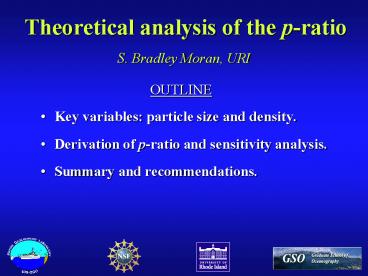Theoretical analysis of the p-ratio - PowerPoint PPT Presentation
1 / 24
Title:
Theoretical analysis of the p-ratio
Description:
Theoretical analysis of the p-ratio S. Bradley Moran, URI OUTLINE Key variables: particle size and density. Derivation of p-ratio and sensitivity analysis. – PowerPoint PPT presentation
Number of Views:121
Avg rating:3.0/5.0
Title: Theoretical analysis of the p-ratio
1
Theoretical analysis of the p-ratio
S. Bradley Moran, URI
OUTLINE
- Key variables particle size and density.
- Derivation of p-ratio and sensitivity analysis.
- Summary and recommendations.
2
Key variables particle size and density
salp
copepod
1 mm
euphausiid
Courtesy of Alice Alldredge
Courtesy of Debby Steinberg
3
(No Transcript)
4
Some questions regarding POC/234Th ratios and POC
flux
- How should we sample POC/234Th ratios to get an
accurate POC export flux? Filtration what size?
Traps what kind? - What is the size-distribution of POC and 234Th?
- Are all phases of POC in equilibrium with 234Th?
- How are POC/234Th ratios (and hence POC flux)
related to changes in particle density, size and
hence sinking speed? - Given range and variability in POC/234Th ratios,
how do we assess the accuracy of POC export flux?
5
Model derivation of the p-ratio
6
Model derivation of the p-ratio
7
Model derivation of the p-ratio
8
(No Transcript)
9
(No Transcript)
10
(No Transcript)
11
(No Transcript)
12
(No Transcript)
13
(No Transcript)
14
Constant Density w/ Low Flux (LF) and High Flux
(HF)
p-ratio
15
(No Transcript)
16
Variable Density w/ Low Flux (LF) and High Flux
(HF)
p-ratio
17
(No Transcript)
18
Particle Assemblage 1 POC density 1060
p-ratio
19
(No Transcript)
20
Particle Assemblage 2 POC density 1300
p-ratio
21
Summary
- The p-ratio is an indicator of the accuracy of
234Th -derived POC fluxes. - For p-ratio (PPOC/FPOC) 1, average sinking
speed of POC- and Th-carrying particles must be
equal. - Accurate measurement of POC export flux requires
p-ratio 1 at base of euphotic zone. - p-ratio 1 does not mean that residence times of
POC and 234Th are equal in the euphotic zone.
22
What does all of this mean?
- Open Ocean
- Biogenic particles dominate POC- and Th-carrying
particles may have reasonably similar sinking
speeds - p-ratio approaches 1.
- However, dust/mineral inputs, org. C
remineralization will increase p-ratio. - Shelf-Slope
- More inorganic (small, high density) particles
that scavenge Th - p-ratio will increase.
23
Questions to think about
- How do we best determine the p-ratio?
- To what extent do operationally defined sampling
methods affect the p-ratio? - How much does the p-ratio vary for different
oceanic regions (opal, carbonate, lithogenic)?
24
Future Work
- Determine particle size-distributions, densities
and sinking speeds of POC- and 234Th-carrying
particles. - Relate measurements of p-ratio to density of
size-fractionated particles over range of
particle types. - Develop models of particle-234Th interactions and
POC/234Th size-distributions and test against
p-ratio.































